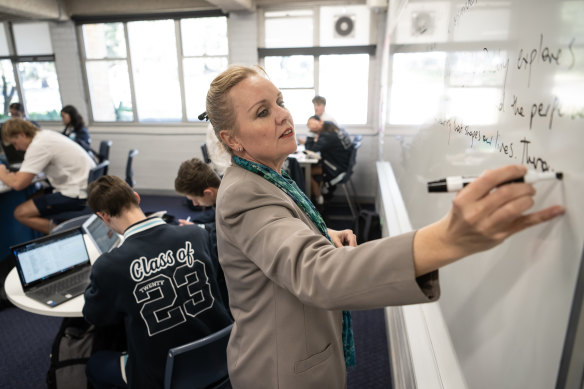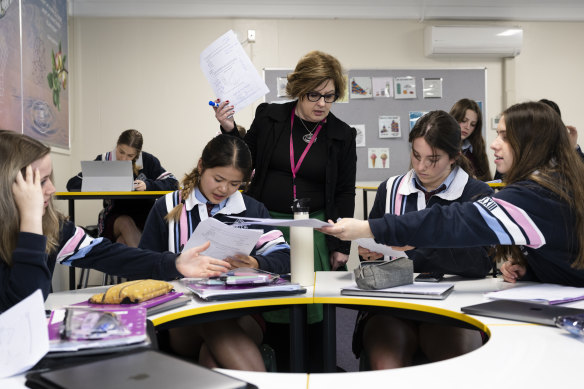By Lucy Carroll, Nigel Gladstone and Syed Ahmad
Students in Sydney’s north and north-west have recorded the highest average HSC scores among public comprehensive and selective schools over the past three years, data has revealed.
A Herald analysis has examined public schools’ average scores in each subject – published in annual reports – showing schools that are achieving consistently strong results across their whole student cohort.

Menai High School has reported an average HSC score of 88 in advanced English over the past three years.Credit: Wolter Peeters
For more than 20 years, the NSW government has released limited HSC data that includes only the names and schools of students who finish in the top performance band in their chosen subjects.
Annual league tables, which are based on band 6 scores (a mark of 90 or more) as a proportion of course entries, are generally dominated by fully selective and high-fee private schools. An analysis of average HSC scores over three years, reported by 375 public schools, aims to give a clearer picture of achievement across student year groups.
The new analysis contains only public schools that report their average HSC scores, including results over a three-year period. Most non-government schools do not routinely report averages.
What does the analysis of average HSC scores show?
Selective schools, which choose pupils based on their results in fiercely competitive entrance exams, still lead the rankings when analysing average scores. Over the past three years, James Ruse Agricultural High, North Sydney Boys’ and Baulkham Hills High took out the top spots, each achieving an average above 90 when the mean of all subjects is taken.
Comprehensive schools including Cheltenham Girls, Killara High, Epping Boys, Willoughby Girls, Carlingford and Castle Hill High rise significantly on the average score rank, putting them among the top 30 schools with an average above 80.
Last year, Cheltenham Girls ranked 93rd on only band 6s, but surges to 19th among public schools on average scores across all subjects.
Schools including Fairvale High, Cherrybrook Technology High, St Ives High, Glenwood High and Lambton High have achieved consistently high average scores on all subjects. Over the past three years, Lambton achieved an average score of 81.7 in business studies, Fairvale an 81 in advanced maths and St Ives an 80 or above in physics and chemistry.
Analysing average scores in advanced English and mathematics
Data reveals Balgowlah Boys’, Killarney Heights, Sylvania High, Menai High and Ashfield Boys’ are among the top 10 schools for average scores in advanced English, outperforming some selective schools. All five schools have reported average scores in that subject between 85 and 89 from 2020 to 2022.
Sylvania High principal Renee Holz says an intense focus on analysing HSC results, combined with explicit and direct instruction in all subjects, have been key in achieving sustained high marks. “Our maths extension 1 and 2 results in 2021 were outstanding. Every student got a top band E4 and were taught by two incredible teachers, with one of them an early career teacher,” Holz says.
Holz says school executives and teachers interrogate HSC results by subject to help the school make decisions about areas to focus on for the following year. “It’s a hugely powerful exercise,” she says.
An English teacher and former HSC marker, Holz draws on her experience to give in-depth feedback to students on their trial essays. “For the past four years, I have given extensive comments on all assessments and practice essays, as do many of our teachers.
“It’s a team effort with incredibly capable teachers who recognise that high results in one subject can be contributed by the teaching in another course. We also have a sustained focus on academic achievement. Not every student is going to get a band 6, but all students are capable of growth.”

Sylvania High Principal Renee Holz teaching year 12 English students.Credit: Wolter Peeters
On the opposite side of the city, at Cheltenham Girls High on the upper north shore, principal Suellen Lawrence says the school has a similarly relentless drive to lift literacy results. It was last year’s top-performing comprehensive school on average scores across all subjects.
The 1400-pupil school has a dedicated homework centre after school hours, and 20 minutes of silent reading every morning. “At 10am when we start the dedicated reading block the whole school is just completely quiet,” says Lawrence. “There are no interruptions… students can’t just skip it.
“We’ve also set aside three lessons a week when our year 7 to 9 students are purely working on their writing, analysing text types or on grammar and spelling skills,” she says.
When analysing the highest average scores in advanced mathematics, Lambton High in Newcastle, Menai High and Strathfield Girls are among the top 30 comprehensive schools. All three schools had an average score of at least 82 in that subject.
Luke Meagher, deputy principal at Menai High, who has taught at the school for 15 years, says teachers have high expectations of all students. “We also deliberately offer a broad range of about 40 HSC subjects, which helps contribute to a learning culture that engages all students.”
“In 2015, we had incredibly strong results in advanced English. Since then, the whole English teaching staff has turned over, but the culture has stayed the same. There is no magic bullet, but we focus on wellbeing for all students and really promoting, and normalising, academic achievement.”
Almost a decade ago, the school started a program called “nerdherd”, where all year 12 students produced their own posters as a reminder that studying and working hard was cool. That celebration of academic success has remained, says Meagher.
The case for more HSC data
Principals and private school sector bosses have long raised concerns that rankings based on purely band 6 data leaves parents in the dark, recognises a narrow definition of success and has created a perverse incentive for schools to promote less challenging courses to boost top band results.
Authorities restricted HSC reporting following the “Class We Failed” scandal in 1997, when The Daily Telegraph reported on low results of a particular Sydney high school.
Former chair of the NSW Education Standards Authority, Tom Alegounarias, says reporting a wider set of HSC measures, including median scores and post-school destinations, could present a richer and more comprehensive snapshot of results.

Maths teacher Sarah Hamper with year 12 students at Cheltenham Girls High School.Credit: Janie Barrett
“It is most important that policymakers are informed by a wide range of data, and by trends over time, rather than a snapshot. Of course parents and students are also entitled to understand the effectiveness of the provision they are receiving,” he says.
Catholic Schools NSW chief executive Dallas McInerney agrees that publishing a range of high-quality measures, including median ATAR and post-school outcomes, would recognise different measures of success that vary by school and student. “It also balances the right to information for parents,” he says.
A spokesperson for the NSW Education Standards Authority said authorities are “continuing to look at new and additional information to report the breadth of achievement of HSC students”.
Each year, schools receive their students’ exam mark and school assessment mark. These are averaged to give an HSC mark, with public schools generally reporting these results.
“It is up to schools and school sectors how they report these results,” the NESA spokesperson said.
The data contained in this analysis was originally collated by year 12 student Syed Ahmad, who researched HSC performance at schools and across all subjects. His work is published at hscscalinggraphs.au/rankingsearch
Tomorrow: Schools that excel in particular subjects